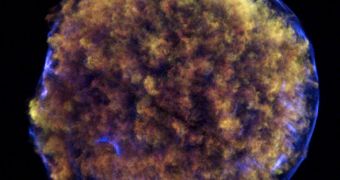One of the things that will always remain true about the Universe is that we will never know everything about it. Nevertheless, experts are taking small steps towards revealing its hidden nature, and they are now getting help from a most unlikely allied – dead white dwarf stars that are returning to life.
These so-called zombie stars are the former remnants of dead Sun-like stars, which are now reverting back to an active state. The events are marked by massive cosmic explosions, which researchers can analyze for precious data.
In scientific terms, these objects are known as Type Ia supernovas, astronomers say. Using information collected by studying them, investigators hope to gain a deeper understanding of dark energy. The stuff is believed to be responsible for the ever-accelerating expansion of the Universe.
It also makes up about 74 percent of all the Cosmos. About 22 percent is accounted for by dark matter, with normal, baryonic matter accounting for only 4 percent of the mass. These 4 percents include all visible matter, such as that in stars, galaxies, black holes, cosmic dust, hydrogen gas and so on.
White dwarfs “are tools for measuring dark energy. They're all about the same brightness, so we can use them to figure out distances in the Universe,” University of California in Santa Barbara (UCSB) astronomer Andy Howell explains.
He is the author of a review article touching on the issue of Type Ia supernovas. The work is published in the June 14 issue of the top scientific journal Nature Communications, Space reports.
This class of supernova explosions are produced exclusively in binary systems where one of the stars is a small, dense white dwarf. These objects are the remnants of Sun-like stars, cramming an entire solar mass in a space the size of Earth.
These structures become zombies when they begin to accrete matter from their companions, or when they merge with them. In the former case, the excess matter destabilizes the star, eventually leading to a massive explosion that can be seen from most places in the Universe.
It's through studies of revived white dwarfs that investigators came to propose the existence of dark energy, more than two decades ago. These light sources are fixed, therefore any differences in measurements conducted at different times imply that the galaxies they're in are moving away.
“What we've found is that the Universe hasn't been expanding at the same rate. And it hasn't been slowing down as everyone thought it would be, due to gravity. Instead, it has been speeding up. There's a force that counteracts gravity, and we don't know what it is. We call it dark energy,” Howell says.
“The next decade holds real promise of making serious progress in the understanding of nearly every aspect of supernovae Ia, from their explosion physics, to their progenitors, to their use as standard candles,” the investigator wrote in his review paper.
“And with this knowledge may come the key to unlocking the darkest secrets of dark energy,” he concludes.

 14 DAY TRIAL //
14 DAY TRIAL //